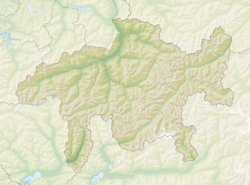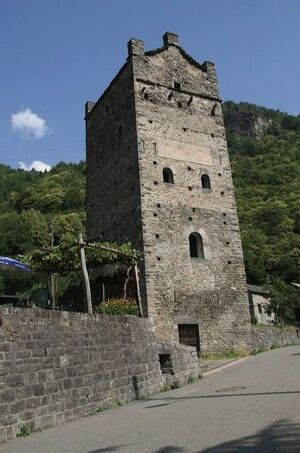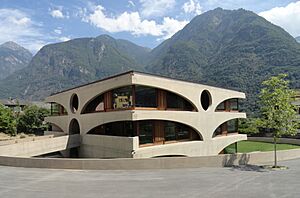Grono, Switzerland facts for kids
Quick facts for kids
Grono
|
||
|---|---|---|
|
||
| Country | Switzerland | |
| Canton | Graubünden | |
| District | Moesa | |
| Area | ||
| • Total | 37.12 km2 (14.33 sq mi) | |
| Elevation | 336 m (1,102 ft) | |
| Population
(Dec 2020 )
|
||
| • Total | 1,397 | |
| • Density | 37.635/km2 (97.47/sq mi) | |
| Postal code |
6537
|
|
| Surrounded by | Cama, Castaneda, Dosso del Liro (IT-CO), Leggia, Roveredo, Santa Maria in Calanca, Verdabbio | |
Grono is a small town, or municipality, in Switzerland. It is located in the Moesa Region, in the part of the Swiss canton of Grisons where people speak Italian. On January 1, 2017, two nearby towns, Leggia and Verdabbio, joined with Grono to form a larger municipality.
Contents
Grono's Past: A Look at Its History
Grono was first written about in old documents in the year 1219. Back then, it was called de Grono. Later, in 1395, it was known as de Agrono. This shows that Grono has been a known place for a very long time!
How Leggia and Verdabbio Joined Grono
The town of Leggia was first mentioned in records in 1295. Verdabbio appeared even earlier, in 1203. These two towns became part of Grono in 2017. This merger made Grono a bigger and more important municipality in the region.
Exploring Grono's Geography
After the towns joined in 2017, Grono became larger. About 8.6% of its land is used for farming. A big part, 58.4%, is covered by forests. Buildings and roads take up 4.5% of the land. The remaining 28.5% is land that cannot be used for farming or building.
Land Use and Natural Features
For farming, Grono has areas for orchards and vineyards. There are also fields for crops and grasslands for animals. Some land is used for grazing animals in the mountains. The amount of farm land has changed over the years. Rivers and lakes cover about 32 hectares (79 acres) in the municipality. Grono is located by the Moesa river, where another river, the Calanca, flows into it.
Who Lives in Grono: Population Facts
As of 2017, Grono has a population of about 1,000 people. Many people who live here were born in other countries. For example, in 2015, about 15% of the people were born in Italy. About 9% were born in Portugal. The number of people living in Grono has been growing.
Understanding Grono's Community
In 2000, slightly more than half of the people in Grono were male (51.4%). The rest were female (48.6%). The town has people of all ages. About 10% are young children (0-9 years old). Teenagers (10-19 years old) make up about 9% of the population. Adults (20-59 years old) are the largest group, making up about 56%. Older adults (60-99 years old) make up about 24% of the population.
In 2015, there were 385 single people living in Grono. There were 507 married people or those in a civil partnership. Also, 56 people were widows or widowers, and 72 residents were divorced.
Homes and Households in Grono
In 2014, Grono had 428 private homes. On average, about 2.3 people lived in each home. Most of the buildings where people live are single-family homes (63.7%). Some are buildings with multiple families (15.8%). Many buildings in Grono are quite old. About 24% were built before 1919. However, some new homes are also being built.
Population Changes Over Time
Here is a table showing how Grono's population has changed through history:
| year | population |
|---|---|
| 1773 | 296 |
| 1850 | 517 |
| 1900 | 484 |
| 1950 | 528 |
| 2000 | 916 |
Important Buildings: Heritage Sites
The Torre Fiorenzana is a very important historical building in Switzerland. It is considered a national heritage site.
The Story of Torre Fiorenzana
The Torre Fiorenzana is a medieval tower. It was built around the end of the 12th century for a family called Sacco. It has five floors and a rectangular shape. In 1406, a sad event happened there: Alberto de Sacco was murdered in the tower. The tower was fixed up in 1977 and is now owned by a local museum.
Cool Places to See in Grono
- The Schoolhouse: This modern building was designed by a famous architect named Raphael Zuber. It was built between 2007 and 2011.
Grono's Weather and Climate
Grono has a type of weather called an oceanic climate. This means it has warm, humid summers and cold, snowy winters.
Temperature Records
Grono holds a special record for Switzerland. The highest temperature ever recorded in the country was in Grono. It was 41.5°C (106.7°F) on August 11, 2003, during a very hot summer in Europe. In contrast, the coldest temperature ever in Switzerland was -41.8°C (-43.2°F) in another town called La Brévine.
Rainfall and Snowfall in Grono
Between 1991 and 2020, Grono had rain on about 100 days each year. On average, it received about 1317 millimeters (51.9 inches) of rain and snow. The wettest month is usually August, with the most rain. February is typically the driest month. Grono also gets some snow, especially in winter.
| Climate data for Grono (1991–2020) | |||||||||||||
|---|---|---|---|---|---|---|---|---|---|---|---|---|---|
| Month | Jan | Feb | Mar | Apr | May | Jun | Jul | Aug | Sep | Oct | Nov | Dec | Year |
| Mean daily maximum °C (°F) | 6.0 (42.8) |
8.8 (47.8) |
14.0 (57.2) |
17.6 (63.7) |
21.2 (70.2) |
25.2 (77.4) |
27.5 (81.5) |
26.8 (80.2) |
22.0 (71.6) |
16.7 (62.1) |
10.6 (51.1) |
6.1 (43.0) |
16.9 (62.4) |
| Daily mean °C (°F) | 0.8 (33.4) |
2.8 (37.0) |
7.3 (45.1) |
11.0 (51.8) |
14.8 (58.6) |
18.5 (65.3) |
20.4 (68.7) |
19.9 (67.8) |
15.6 (60.1) |
11.0 (51.8) |
5.7 (42.3) |
1.2 (34.2) |
10.8 (51.4) |
| Mean daily minimum °C (°F) | −2.5 (27.5) |
−1.4 (29.5) |
2.1 (35.8) |
5.3 (41.5) |
9.2 (48.6) |
13.0 (55.4) |
14.7 (58.5) |
14.7 (58.5) |
11.1 (52.0) |
7.1 (44.8) |
2.3 (36.1) |
−1.9 (28.6) |
6.1 (43.0) |
| Average precipitation mm (inches) | 69 (2.7) |
49 (1.9) |
62 (2.4) |
106 (4.2) |
142 (5.6) |
154 (6.1) |
145 (5.7) |
164 (6.5) |
138 (5.4) |
134 (5.3) |
147 (5.8) |
71 (2.8) |
1,317 (51.9) |
| Average snowfall cm (inches) | 24.5 (9.6) |
10.4 (4.1) |
5.0 (2.0) |
0.7 (0.3) |
0.0 (0.0) |
0.0 (0.0) |
0.0 (0.0) |
0.0 (0.0) |
0.0 (0.0) |
0.4 (0.2) |
3.7 (1.5) |
19.0 (7.5) |
63.7 (25.1) |
| Average precipitation days (≥ 1.0 mm) | 5.4 | 4.6 | 5.9 | 8.7 | 12.1 | 10.8 | 9.8 | 10.6 | 8.5 | 8.5 | 8.8 | 6.0 | 99.7 |
| Average snowy days (≥ 1.0 cm) | 2.3 | 2.0 | 0.8 | 0.2 | 0.0 | 0.0 | 0.0 | 0.0 | 0.0 | 0.1 | 0.7 | 2.2 | 8.3 |
| Average relative humidity (%) | 72 | 65 | 61 | 64 | 71 | 72 | 71 | 74 | 77 | 82 | 78 | 75 | 72 |
| Source: MeteoSwiss (snow 1981–2010) | |||||||||||||
Grono's Economy: How People Work
Grono is a place where many people work in services and industries. Farming and manufacturing are not the main jobs here. In 2014, there were 825 people working in the municipality.
Jobs in Different Areas
- Primary Sector: Only a few people (6) work in farming or fishing.
- Secondary Sector: About 343 people work in factories or construction. Many of these jobs are in smaller businesses.
- Tertiary Sector: The largest number of jobs (476) are in services. This includes shops, offices, and other service-based businesses.
In 2014, a small number of people (2%) in Grono received social assistance. This means they got help from the government.
Learning and Education in Grono
Many adults in Grono have a good education. About 56% of people aged 25 to 64 have finished high school or gone on to higher education. This includes university or special colleges.
See also
 In Spanish: Grono para niños
In Spanish: Grono para niños






